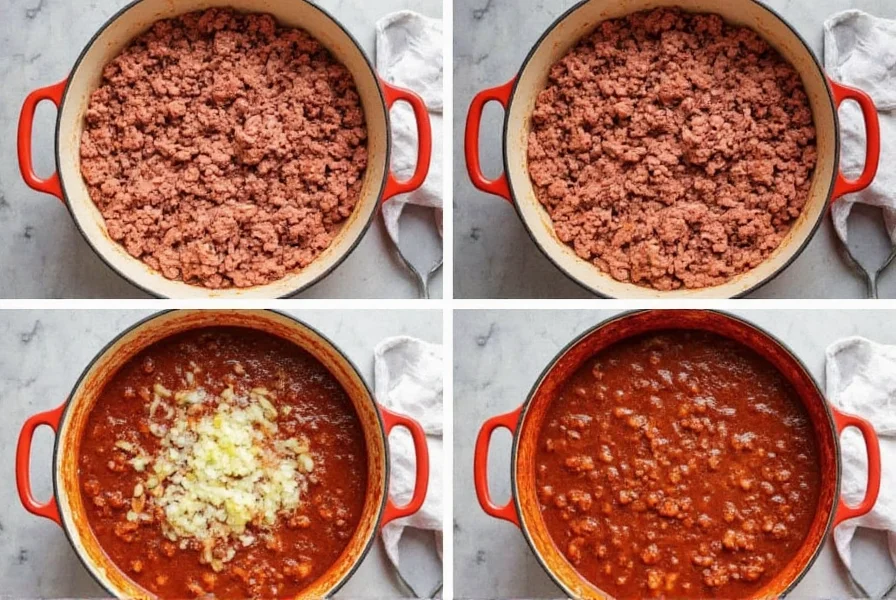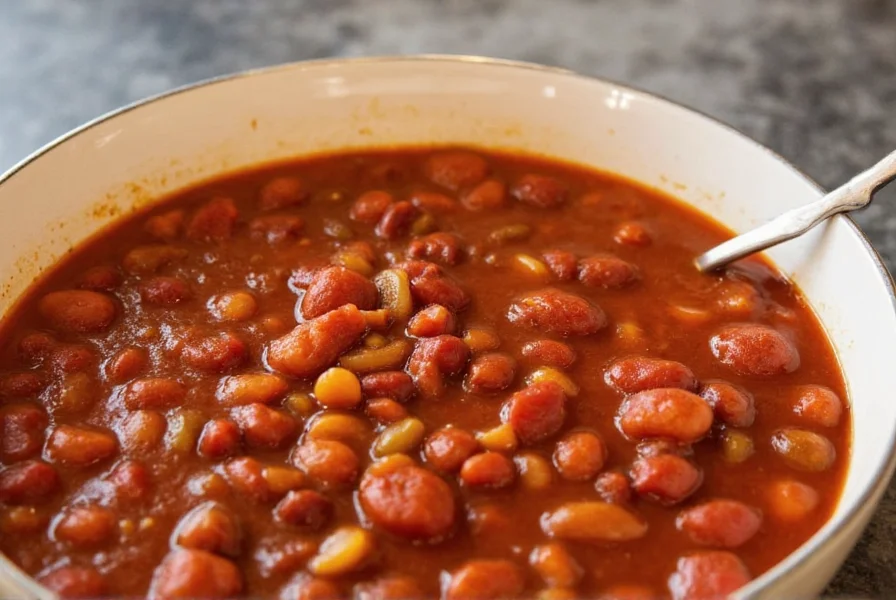Making delicious homemade chili doesn't require professional cooking skills or exotic ingredients. Whether you're preparing a weeknight dinner or feeding a crowd at a game day gathering, this straightforward approach delivers consistent results with minimal effort. The magic happens through proper browning of meat, balanced seasoning, and adequate simmering time to let flavors meld together perfectly.
Essential Ingredients for Perfect Homemade Chili
The foundation of any great chili recipe starts with quality ingredients. Here's what you'll need for a classic meat-based chili that serves 6-8 people:
- 1 pound ground beef (80% lean works best for flavor)
- 1 large yellow onion, finely diced
- 3-4 garlic cloves, minced
- 28-ounce can crushed tomatoes
- 15-ounce can kidney beans, drained and rinsed
- 4-ounce can diced green chilies
- 2 tablespoons chili powder (adjust to taste)
- 1 tablespoon ground cumin
- 1 teaspoon smoked paprika
- 1 teaspoon dried oregano
- 1/2 teaspoon cayenne pepper (optional for heat)
- Salt and black pepper to taste
- 1 cup beef broth or water
For those seeking a vegetarian alternative for homemade chili, simply substitute the ground beef with 2 cups of cooked lentils or a plant-based ground "meat" alternative, and use vegetable broth instead of beef broth.

Equipment You'll Need
Before you start cooking, gather these essential tools:
- Large heavy-bottomed pot or Dutch oven (5-6 quart capacity)
- Wooden spoon or heat-resistant spatula
- Sharp chef's knife
- Cutting board
- Measuring spoons and cups
- Can opener
Step-by-Step Cooking Instructions
Follow these detailed steps for how to make chili taste better than restaurant versions:
- Brown the meat: Heat your pot over medium-high heat. Add the ground beef, breaking it into small pieces with your spoon. Cook until well-browned (not just grayed), about 8-10 minutes. Proper browning creates flavor compounds essential for depth.
- Add aromatics: Stir in the diced onion and cook until translucent (about 5 minutes). Add the minced garlic and cook for 1 minute more until fragrant.
- Build flavor base: Add all spices (chili powder, cumin, paprika, oregano, cayenne if using) and stir for 30 seconds to toast the spices and release their oils.
- Add liquids and tomatoes: Pour in the crushed tomatoes and beef broth, stirring to combine with the meat and spices.
- Incorporate beans and chilies: Add the kidney beans and diced green chilies. Stir well to combine all ingredients.
- Simmer to perfection: Reduce heat to low, cover partially, and let the chili simmer for 45-60 minutes, stirring occasionally. The longer it simmers (up to 2 hours), the better the flavor development.
- Final seasoning: Taste and adjust salt, pepper, and spice levels. If the chili is too thick, add a splash of broth or water.
| Cooking Stage | Temperature | Time | Visual Cues |
|---|---|---|---|
| Browning meat | Medium-high | 8-10 min | Deep brown color, no pink remaining |
| Sautéing onions | Medium | 5 min | Translucent, no raw bite |
| Simmering chili | Low | 45-120 min | Thickened consistency, rich aroma |
Common Mistakes to Avoid When Making Homemade Chili
Even experienced cooks can fall into these chili-making traps. Avoid these common errors for best results:
- Skipping the meat browning step: Gray meat instead of browned meat results in bland flavor. Take time to properly sear the beef.
- Adding all liquid at once: Build layers of flavor by adding ingredients in sequence rather than dumping everything in together.
- Not simmering long enough: Chili needs time for flavors to meld. Rushing this step yields a disjointed taste profile.
- Over-relying on canned chili seasoning: Freshly measured spices create better balance than pre-mixed packets.
- Adding beans too early: If using dried beans (instead of canned), add them earlier. For canned beans, adding them later preserves texture.

Customization Options for Your Homemade Chili
One of the beauties of this traditional Texas-style chili recipe is its adaptability. Try these variations:
- For extra richness: Stir in 1 tablespoon of unsweetened cocoa powder or a square of dark chocolate during the last 15 minutes of cooking.
- For smoky depth: Add 1-2 chipotle peppers in adobo sauce, finely chopped.
- For texture variation: Include 1 cup of corn kernels (frozen or canned) with the beans.
- For slow cooker chili instructions: After browning meat and sautéing aromatics, transfer everything to a slow cooker and cook on low for 6-8 hours.
- Dietary adaptations: For gluten-free chili, ensure all ingredients (particularly spice blends) are certified gluten-free.
Storage and Reheating Tips
Homemade chili often tastes even better the next day as flavors continue to develop. Here's how to store it properly:
- Cool completely before storing (within 2 hours of cooking)
- Store in airtight containers in the refrigerator for up to 4 days
- Freeze in portion-sized containers for up to 3 months
- Reheat on stove over medium-low heat, stirring occasionally
- Add a splash of broth or water when reheating to restore ideal consistency
Frequently Asked Questions
How long should I simmer chili for the best flavor?
For optimal flavor development, simmer chili for at least 45 minutes, though 90 minutes to 2 hours yields significantly better results. The extended cooking time allows flavors to meld and deepen. If using a slow cooker, 6-8 hours on low produces exceptional results. The chili is ready when it has thickened to your liking and the aroma is rich and complex.
Can I make homemade chili without beans?
Yes, authentic Texas-style chili traditionally contains no beans. Simply omit the kidney beans and increase the meat by 1/2 pound or add 1 cup of additional diced vegetables like bell peppers or zucchini. You may need to reduce liquid by 1/4 cup since beans absorb moisture. The cooking time remains the same, but the texture will be thicker and meat-focused.
What's the secret to making chili taste better?
The secret to making chili taste better lies in three key techniques: properly browning the meat to develop fond, toasting the spices before adding liquids to release their essential oils, and allowing adequate simmering time for flavor integration. Additional flavor boosters include a splash of coffee, a square of dark chocolate, or a small amount of vinegar added at the end to brighten flavors. Don't rush the process—good chili requires patience.
How can I adjust the heat level in my chili?
To increase heat, add more cayenne pepper, diced jalapeños, or a few dashes of hot sauce during cooking. For milder chili, reduce or eliminate cayenne and use mild chili powder. Remember that heat intensifies over time, so if you prefer medium heat, start with less spice and adjust near the end of cooking. Adding dairy toppings like sour cream when serving will also counteract excessive heat.











 浙公网安备
33010002000092号
浙公网安备
33010002000092号 浙B2-20120091-4
浙B2-20120091-4